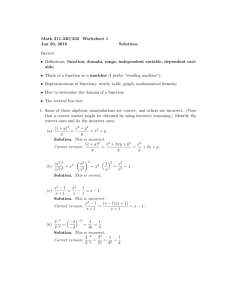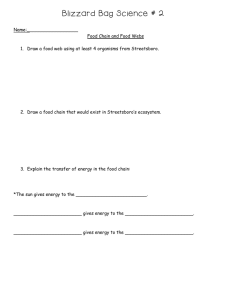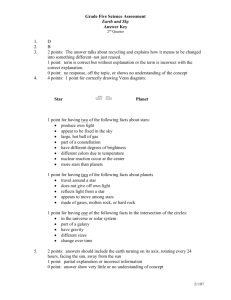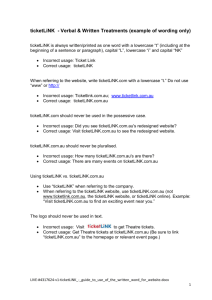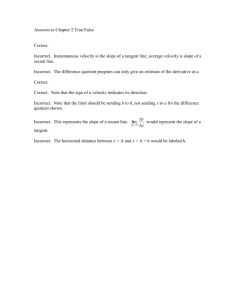SAP EDUCATION - Training and Certification Shop
advertisement
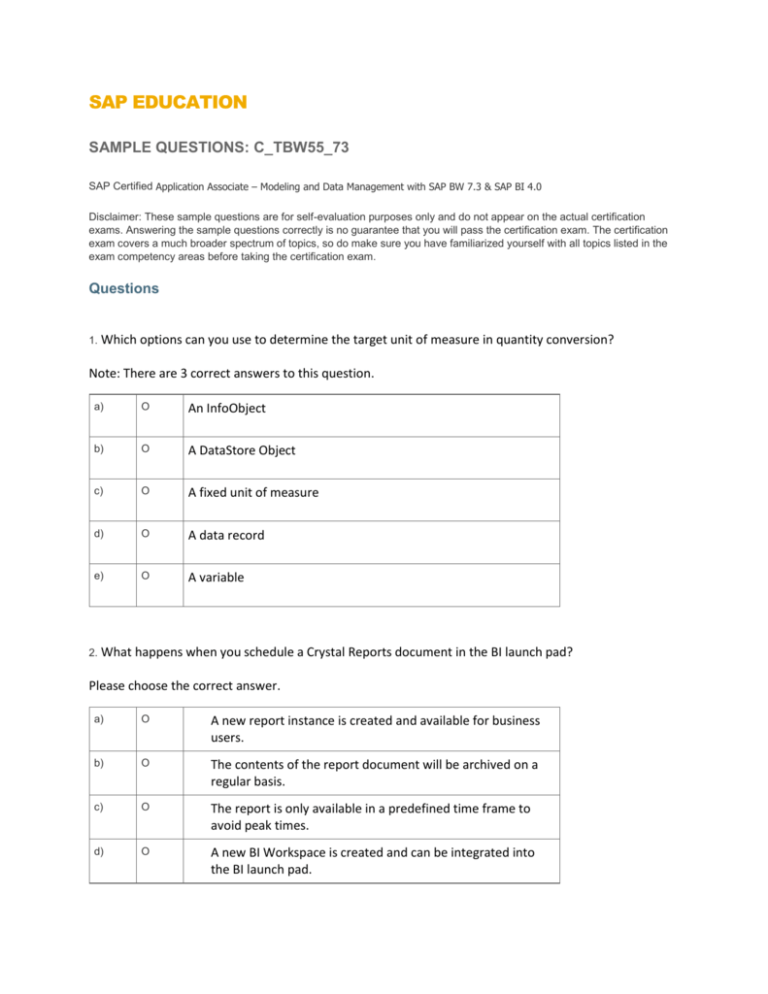
SAP EDUCATION SAMPLE QUESTIONS: C_TBW55_73 SAP Certified Application Associate – Modeling and Data Management with SAP BW 7.3 & SAP BI 4.0 Disclaimer: These sample questions are for self-evaluation purposes only and do not appear on the actual certification exams. Answering the sample questions correctly is no guarantee that you will pass the certification exam. The certification exam covers a much broader spectrum of topics, so do make sure you have familiarized yourself with all topics listed in the exam competency areas before taking the certification exam. Questions 1. Which options can you use to determine the target unit of measure in quantity conversion? Note: There are 3 correct answers to this question. a) O An InfoObject b) O A DataStore Object c) O A fixed unit of measure d) O A data record e) O A variable 2. What happens when you schedule a Crystal Reports document in the BI launch pad? Please choose the correct answer. a) O A new report instance is created and available for business users. b) O The contents of the report document will be archived on a regular basis. c) O The report is only available in a predefined time frame to avoid peak times. d) O A new BI Workspace is created and can be integrated into the BI launch pad. 3. Which DataSource types can you use to create VirtualProviders? Note: There are 3 correct answers to this question? a) O Relational Source b) O SAP Source c) O Web services d) O Universe Connections e) O Flat files 4. You want to report all products that were not sold or sold very little in the last six months. How can you model this requirement? Note: There are 2 correct answers to this question. a) O Use an InfoSet with an INNER JOIN from the master data to the sales transaction data. b) O Use an InfoSet with a LEFT OUTER JOIN from the master data to the sales transaction data. c) O Use the InfoProvider containing the sales transaction data and set the Read Mode of the material characteristic to "Master Data" in BEx Query Designer. d) O Use the InfoProvider containing the sales transaction data and set the Read Mode of the InfoProvider to "Master Data". 5. When is a change run required after successful completion of the data load? Please choose the correct answer. a) O When changes are made to texts from characteristics used in an aggregate b) O When changes are made to attributes or hierarchies from characteristics used in an aggregate c) O When changes are made to attributes, hierarchies, or texts from characteristics d) O When changes are made to the structure of the InfoCube 6. Which of the following are standard components of Data Services Architecture? Note: There are 3 correct answers to this question. a) O Job Server b) O Access Server c) O Explorer Search Server d) O Address Server e) O Web Application Server 7. You have changed an InfoCube. The modified version needs to be approved by the technical team. Before approval, what must you do to avoid losing the active version of the InfoCube? Please choose the correct answer. a) O Save and transport b) O Activate only c) O Save and activate d) O Save only 8. For which fields of a DataStore Object can you use the overwrite method in transformations? Please choose the correct answer. a) O Data fields of type key figure b) O Key fields of type key figure c) O Data fields of type characteristic d) O Key fields of type characteristic 9. You want to search, filter, and drill through Information Spaces and view only interested in via advanced visualizations or charts. Which reporting tool do you use? Please choose the correct answer. a) O SAP BusinessObjects Explorer b) O SAP Crystal Reports c) O SAP BusinessObjects Web Intelligence the data you are d) O SAP BusinessObjects Dashboards 10. Which adapter do you use to load data directly from Hyperion, which is a multi-dimensional data source? Please choose the correct answer. a) O File Interface b) O DB Connect c) O Staging BAPI d) O UD Connect Solutions 1 a) Correct 2 a) Correct 3 a) Correct 4 a) Incorrect 5 a) Incorrect 1 b) Incorrect 2 b) Incorrect 3 b) Correct 4 b) Correct 5 b) Correct 1 c) Correct 2 c) Incorrect 3 c) Incorrect 4 c) Correct 5 c) Incorrect 1 d) Incorrect 2 d) Incorrect 3 d) Incorrect 4 d) Incorrect 5 d) Incorrect 1 e) Correct 3 e) Correct 6 a) Correct 7 a) Incorrect 8 a) Correct 9 a) Correct 10 a) Incorrect 6 b) Correct 7 b) Incorrect 8 b) Incorrect 9 b) Incorrect 10 b) Incorrect 6 c) Incorrect 7 c) Incorrect 8 c) Incorrect 9 c) Incorrect 10 c) Incorrect 6 d) Correct 7 d) Correct 8 d) Incorrect 9 d) Incorrect 10 d) Correct 6 e) Incorrect Want to learn more? Contact SAP for more information.

